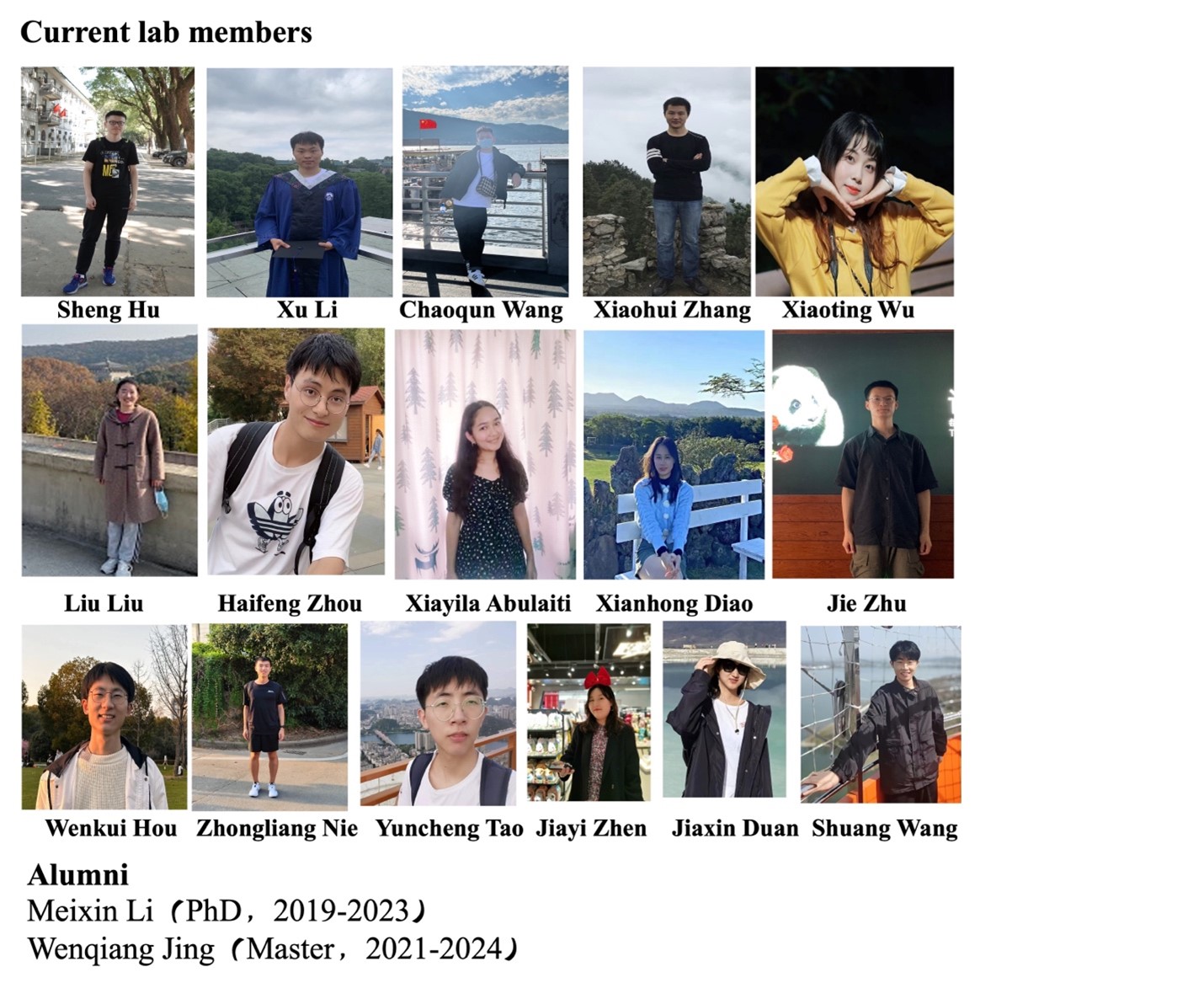
WEI YAN
Principle Investigator/Professor
Affiliation: Dept. of Cell Biology
E-mail: weiyan@whu.edu.cn
My Bibliography:
https://www.ncbi.nlm.nih.gov/myncbi/1J1pZnbY6dTYKE/bibliography/public/
--------------------------------------------------------------------------------
Research Interests:
Cells could communicate with each other through secretion and uptake of extracellular vesicles (EVs) in vivo. According to the biogenesis pathway and size distribution, EVs are further classified into exosomes, ectosomes, apoptotic bodies. Most cell types resided in the same or distant tissue/organ could crosstalk with each other via transfer bioactive cargoes including RNAs, functional proteins, lipids, and metabolites in vivo. The emerging biological functions of EVs on immune disorder and metabolic diseases (such as cancer, obesity or sepsis), facilitate EVs with strong potential clinically applications for diagnosis and drug delivery in various diseases. Ongoing projects include:
1) The regulatory factors involved in EV biogenesis, secretion or uptake under stress stimuli.
2) The biological effect of EVs on interorgan transportation in physiological and pathological condition.
3) EV engineering for clinical applications.
4) The molecular mechanism and function of metabolites on key gene/protein expression.
The long-term goals of these studies are to reveal the molecular mechanism and biological function of EVs in cancer and immune biology and develop novel strategies to treat metabolic disorder diseases.
Education Background & Academic Experience:
Dr. Yan received B.A. degree in Biology in 2009 from Ocean University of China, Qingdao. She then entered a doctoral program at Shanghai Institute of Biochemistry Biology, Chinese Academy of Sciences. She studied the interaction between transfer RNAs and enzyme in Dr. En-duo Wang’s group. She obtained her Ph.D. degree with the major of Molecular Biology and Biochemistry in 2014. Dr. Wei Yan got her post-doctoral training in the laboratory of Dr. Shizhen Emily Wang at Beckman Institute of City of Hope (2014-2016) and University of California, San Diego (2016-2020), studying the biological function of extracellular vesicles in cancer biology. She joined Wuhan University as Professor in 2020.
Now she is serving as an Academic Editor for iScience and Editorial Board member for BMC Cancer. She is also serving as a reviewer for Cell Metabolism, Signal Transduction and Targeted Therapy, SCIENCE CHINA Life Sciences, Cell Reports, Oncogene,Obesity Reviews,Journal of Nanobiotechnology, Scientific Reports, iScience etc.
Research Description:
EVs, a subset heterogeneous population of cell-derived membrane-limited particles, mediate intercellular communication with a fundamental role in tumorigenesis and metastasis. Aiming to address fundamental questions in the tumor metabolism and onco-immunology field and improve human health, we have made scientific achievements as follows.
1. Systemic regulation of extracellular vesicles in cancer (PMID: 35469018; 37620316; 37394346). Cancer-associated cachexia is a multi-organ weight loss syndrome, especially with a wasting disorder of adipose tissue and skeletal muscle. We found that breast cancer suppressed O-linked N-acetylglucosamine (O-GlcNAc) protein modification in muscle through extracellular-vesicle-encapsulated miR-122, which targets O-GlcNAc transferase (OGT). Mechanistically, O-GlcNAcylation of ryanodine receptor 1 (RYR1) competed with NEK10-mediated phosphorylation and increased K48-linked ubiquitination and proteasomal degradation; the miR-122-mediated decrease in OGT resulted in increased RYR1 abundance. We further found that muscular protein O-GlcNAcylation was regulated by hypoxia and lactate through HIF1A-dependent OGT promoter activation and was elevated after exercise. Suppressed O-GlcNAcylation in the setting of cancer, through increasing RYR1, led to higher cytosolic Ca2+ and calpain protease activation, which triggered cleavage of desmin filaments and myofibrillar destruction. This was associated with reduced skeletal muscle mass and contractility in tumour-bearing mice. Our findings link O-GlcNAcylation to muscular protein homoeostasis and contractility and reveal a mechanism of cancer-associated muscle dysregulation. On the other hand, we find breast cancer cell-secreted exosomal miR-204-5p induces hypoxia-inducible factor 1A (HIF1A) in white adipose tissue (WAT) by targeting von Hippel-Lindau (VHL) gene. Elevated HIF1A protein induces the leptin signalling pathway and thereby enhances lipolysis in WAT. Additionally, exogenous VHL expression blocks the effect of exosomal miR-204-5p on WAT browning. Reduced plasma phosphatidyl ethanolamine level is detected in mice lack of cancer-derived miR-204-5p secretion in vivo. Collectively, our study reveals circulating miR-204-5p induces hypoxia-mediated leptin signal- ling pathway to promote lipolysis and WAT browning, shedding light on both preventive screenings and early intervention for cancer-associated cachexia.
2. Linking extracellular vesicles and metabolic reprogramming in tumor microenvironment (PMID: 29662176; 37532694). Cancer and other cells residing in the same niche engage various modes of interactions to synchronize and buffer the negative effects of environmental changes. We show a mechanistic model involving breast-cancer-secreted, extracellular-vesicle-encapsulated miR-105, which is induced by the oncoprotein MYC in cancer cells and, in turn, activates MYC signaling in cancer-associated fibroblasts (CAFs) to induce metabolic reprograming. This results in the capacity of CAFs to display different metabolic features in response to changes in the metabolic environment. When nutrients are sufficient, miR-105-reprogrammed CAFs enhance glucose and glutamine metabolism to fuel adjacent cancer cells. When nutrient levels are low and metabolic by-products accumulate, these CAFs detoxify metabolic wastes, including lactic acid and ammonium, by converting them into energy-rich metabolites. Thus, the miR-105-mediated metabolic reprogramming of stromal cells contributes to sustained tumour growth by conditioning the shared metabolic environment. In our recent work, we identify the induction of 5′-nucleotidase, cytosolic II (NT5C2) gene expression promotes inosine accumulation and maintains cancer cell survival in the nutrient-poor region. Inosine elevation further induces Rag GTPases abundance and mTORC1 signaling pathway by enhancing transcription factor SP1 level in the starved tumor. Besides, inosine supplementary stimulates the synthesis and secretion of nascent TCA cycle enzymes through EVs, including citrate synthesis (CS) and aconitase 1 (ACO1), to further enhance oxidative phosphorylation of breast cancer cells under glucose starvation, leading to the accumulation of iso-citric acid. Inhibition of the CS activity or knockdown of ACO1 blocks the rescue effect of inosine on cancer survival under starvation. Our finding highlights the vital signal role of inosine linking mitochondrial respiration and starvation adaptation, beyond serving as direct energy carriers or building blocks for genetic code in TME, shedding light on future cancer treatment by targeting inosine metabolism.
3. Characterization of the effect of metabolites on gene/protein expression in immune and cancer cycle (PMID: 29337138). |
The control of uptake and utilization of necessary extracellular nutrients-glucose and glutamine-is an
important aspect of B cell activation. Let-7 is a family of microRNAs known to be involved in metabolic control. Collaborated with Dr. David Baltimore in Caltech, we employed several engineered mouse models, including B cell-specific overexpression of Lin28a or the let-7a-1/let-7d/let-7f-1 cluster (let-7adf) and knockout of individual let-7 clusters to show that let-7adf specifically inhibits T cell-independent (TI) antigen-induced immunoglobulin (Ig)M antibody production. Both overexpression and deletion of let-7 in this cluster leads to altered TI-IgM production. Mechanistically, let-7adf suppresses the acquisition and utilization of key nutrients, including glucose and glutamine, through directly targeting hexokinase 2 (Hk2) and by repressing a glutamine transporter Slc1a5 and a key degradation enzyme, glutaminase (Gls), a mechanism mediated by regulation of c-Myc. Our results suggest a novel role of let-7adf as a "metabolic brake" on B cell antibody production. In our current ongoing projects, we identify that some metabolites affect the expression of some crucial genes/proteins, while the underlying mechanism is poorly recognized. We are striving to reveal the mystery of their regulatory mechanism.
Oral Talks:
3rd World Laureates Forum (Young Scientists) 2020, Shanghai
Winter Symposium on Word Cancer Research 2022, Singapore
10th World Congress on Breast Cancer, Cancer Research & Therapy 2023, San Diego
17th Cachexia Conference 2024, Washington DC
Teaching:
Cell Biology for Undergraduates (Spring semester)
Frontiers in Cell Biology for Graduate Students (Fall semester)
Awards:
Travel Grant for Postdoc Fellowship (UCSD), 2018
Discover Glo Innovator (Promega/Chinese Society of Cell Biology), 2022
USCACA-AFCR Scholar Awardee(2024)
Representative Publications (#: Co-first; *: Co-corresponding):
1) Li MX#, Hu S#, Lei HH#, Yuan M, Li X, Hou WK, Huang XJ, Xiao BW, Yu TX, Zhang XH, Wu XT, Jing WQ, Lee HJ, Li JJ, Fu D, Zhang LM* and Yan W*. Tumor-derived miR-9-5p-loaded EVs regulate cholesterol homeostasis to promote breast cancer liver metastasis in mice. Nature Communications In press.
2) Zhou HF, Hu S, Yan W*. Extracellular vesicles as modifiers of epigenomic profiles. Trends in Genetics 2024 June 5; doi.org/10.1016/j.tig.2024.05.005.
3) Hu S#, Zhang XH#, Yan W*. Isolation and characterization of small extracellular vesicles from murine primary mammary tumor. STAR Protoc. 2024 Mar 15;5(1):102783. doi: 10.1016/j.xpro.2023.102783. Epub 2023 Dec 15. PubMed PMID: 38103192; PubMed Central PMCID: PMC10770631.
4)Zhang XH #, Zhao YX#, Yan W*. The role of extracellular vesicles in skeletal muscle wasting. Journal of Cachexia, Sarcopenia and Muscle 2023 Oct 22. doi: 10.1002/jcsm.13364. Online ahead of print. PMID: 37867162.
5)Hu Y#, Liu L#, Chen Y, Zhang XH, Zhou HF, Hu S, Li X, Li MX, Li JJ, Cheng SY, Liu Y, Xu YC* and Yan W*. Cancer-cell-secreted miR-204-5p induces leptin signaling pathway in white adipose tissue to promote cancer-associated cachexia. Nature Communications 2023 Aug 24;14(1):5179. doi: 10.1038/s41467-023-40571-9.
6)Hu S#, Hu Y#, Yan W*. Extracellular vesicle-mediated interorgan communication in metabolic diseases. Trends in Endocrinology and Metabolism 2023 Sep;34(9):571-582. doi: 10.1016/j.tem.2023.06.002. Epub 2023 Jun 30.
7)Li MX#, Wu XT#, Jing WQ#, Hou WK, Hu S, Yan W*. Inosine enhances tumor mitochondrial respiration by inducing Rag GTPases and nascent protein synthesis under nutrient starvation. Cell Death & Disease 2023 Aug 2;14(8):492. doi: 10.1038/s41419-023-06017-2. PMID: 37532694.
8)Yan W*, Cao M, Ruan X, Jiang L, Lee S, Lemanek A, Ghassemian M, Pizzo DP, Wan Y, Qiao Y, Chin AR, Duggan E, Wang D, Nolan JP, Esko JD, Schenk S*, Wang SE*. Cancer-cell-secreted miR-122 suppresses O-GlcNAcylation to promote skeletal muscle proteolysis. Nat Cell Biol. 2022 May;24(5):793-804. doi: 10.1038/s41556-022-00893-0. Epub 2022 Apr 25. PMID: 35469018; PMCID: PMC9107513.
9)Yan W*, Jiang S*. Immune Cell-Derived Exosomes in the Cancer-Immunity Cycle. Trends in Cancer. 2020 March 17; DOI: https://doi.org/10.1016/j.trecan.2020.02.013.
10)Yan W, Wu X, Zhou W, Fong MY, Cao M, Liu J, Liu X, Chen CH, Fadare O, Pizzo DP, Wu J, Liu L, Liu X, Chin AR, Ren X, Chen Y, Locasale JW, Wang SE*. Cancer-cell-secreted exosomal miR-105 promotes tumour growth through the MYC-dependent metabolic reprogramming of stromal cells. Nat Cell Biol. 2018 May;20(5):597-609. PubMed PMID:29662176; PubMed Central PMCID: PMC5920728.
11)Jiang S#, Yan W#, Wang SE*, Baltimore D*. Let-7 Suppresses B Cell Activation through Restricting the Availability of Necessary Nutrients. Cell Metabolism 2018 Feb 6;27(2):393-403.e4. PubMed PMID:29337138.
12)Yan W, Ye Q, Tan M, Chen X, Eriani G, Wang ED*. Modulation of Aminoacylation and Editing Properties of Leucyl-tRNA Synthetase by a Conserved Structural Module. J Biol Chem. 2015 May 8;290(19):12256-67. PubMed PMID:25817995; PubMed Central PMCID: PMC4424357.
13)Yan W#, Tan M#, Eriani G, Wang ED*. Leucine-specific domain modulates the aminoacylation and proofreading functional cycle of bacterial leucyl-tRNA synthetase. Nucleic Acids Res. 2013 May;41(9):4988-98. PubMed PMID:23525458; PubMed Central PMCID: PMC3643597.
14)Tan M#, Yan W#, Liu RJ, Wang M, Chen X, Zhou XL, Wang ED*. A naturally occurring nonapeptide functionally compensates for the CP1 domain of leucyl-tRNA synthetase to modulate aminoacylation activity. Biochem J. 2012 Apr 15;443(2):477-84. PubMed PMID:22292813.


